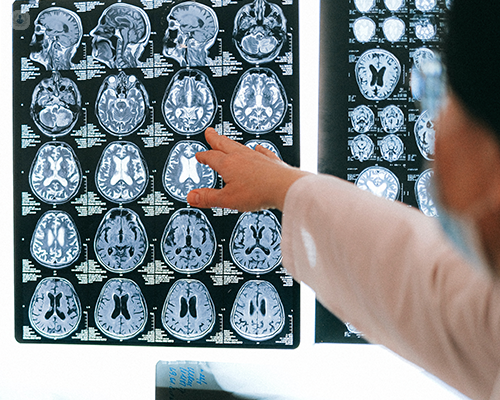White matter lesions explained by a neurologist
Written by:After receiving a brain scan result showing white matter lesions, you’ll likely have lots of questions. Professor Hedley Emsley (a consultant neurologist) explains what white matter lesions are, the range of potential causes, if they can cause problems and more.

My brain scan report mentions white matter lesions – what are these?
White matter lesions are an example of an incidental finding on a brain scan.
What are incidental findings?
These are findings on a brain scan that are unrelated to the reason the scan has been requested. For example, brain scans are sometimes done because a patient is seeking reassurance that there is no sinister cause for their headache. Brain scans requested in this situation can be reassuring but they may show ‘unexpected’ or incidental findings.
Ideally, it is good to be aware of the possibility of incidental findings being identified before having a brain scan.
What are white matter lesions?
White matter lesions affect the white matter . White matter is the deepest part of the brain that contains millions of nerve fibres connecting other parts of the brain and spinal cord. The nerve fibres are surrounded by a fatty material called myelin. This protects the nerve fibres and gives white matter its colour.
Deterioration of the white matter happens with ageing and can be seen on brain scans as white matter lesions (abnormal areas). These appear as bright areas or white matter ‘hyperintensities’ on some brain MRI scans. White matter lesions are one of the most common incidental findings on brain scans. White matter lesions might be referred to as age-related, ‘wear-and-tear’ changes.
Do white matter lesions cause any problems?
Very often, white matter lesions don’t cause any noticeable problems for the individual. Sometimes, white matter disease, particularly when it is severe, can interfere with the way the brain works and the processes that it controls, including thinking and walking. This is because the nerve signals can’t get through as normal.
How common are white matter lesions?
White matter lesions are much more common in older or elderly people. Some studies have found that white matter lesions tend to be seen on the majority of brain scans in older adults but are far less frequently seen on brain scans in younger people.
What causes white matter lesions?
Lots of different diseases, as well as injuries and toxic substances, can cause damage to the white matter. High blood pressure (hypertension ) is a very common cause. Other causes include diabetes mellitus, high cholesterol and smoking. Other factors such as genetics are likely to play a role. Sometimes, white matter lesions are caused by inflammation of the brain.
My brain scan report mentions small vessel cerebrovascular disease. What is this?
Damage to the very small blood vessels in the brain can cause white matter lesions. This is typically the case when high blood pressure or diabetes mellitus are thought to be the cause of the brain scan changes.
The report says the small vessel disease is mild, moderate or severe. What does this mean?
This refers to how many white matter lesions there are and whether they are becoming joined up, or confluent. Very often, people won’t notice any symptoms even if the small vessel disease is severe, but it is wise to ensure that any possible underlying causes are identified to try to prevent the situation getting worse.
My report mentions ‘non-specific’ white matter lesions. What are they?
Very often, white matter lesions are ‘non-specific’ and their appearance doesn’t suggest any particular underlying cause. Non-specific white matter lesions are sometimes seen in people with migraine.
How are white matter lesions treated?
There is no specific treatment for white matter lesions. It is sensible to make sure that treatable conditions such as high blood pressure are recognised and treated in case the white matter lesions are due to this. It is sensible to make sure conditions such as diabetes mellitus and high cholesterol are under control. If you smoke, it is sensible to stop.
Contact Professor Emsley to learn how he can help you with the diagnosis and management of a wide variety of neurological conditions.


